Looking down this list, you might be surprised that tomatoes aren’t mentioned as a crop that can take the heat. And that’s because tomatoes—while they’re considered warm-weather crops—aren’t necessarily hot-weather crops.
And there is a difference!
If you live in a hot climate like Southern California, Arizona, New Mexico, Texas, Florida, and other parts of the South and Southwest, you know it’s a struggle to grow food in the peak of summer. (And I speak from personal experience: I grew up in Las Vegas, Nevada, where it regularly tops 100°F before summer even starts.)
Many leafy greens start bolting at the first sign of a heat wave. The quintessential summer vegetables (tomatoes, cucumbers, beans, and squash) may love warm weather, but they need a cooling-off period at night to recover. If it never drops below 75°F, your plants will suffer.
But you don’t have to give up your vegetable garden entirely in summer! Even if your climate stays hot for at least 60 to 90 days, you can still grow plenty of delicious plants. The key is making sure you grow the right types—and grow them strategically.
Disclosure: If you shop from my article or make a purchase through one of my links, I may receive commissions on some of the products I recommend.
Arugula
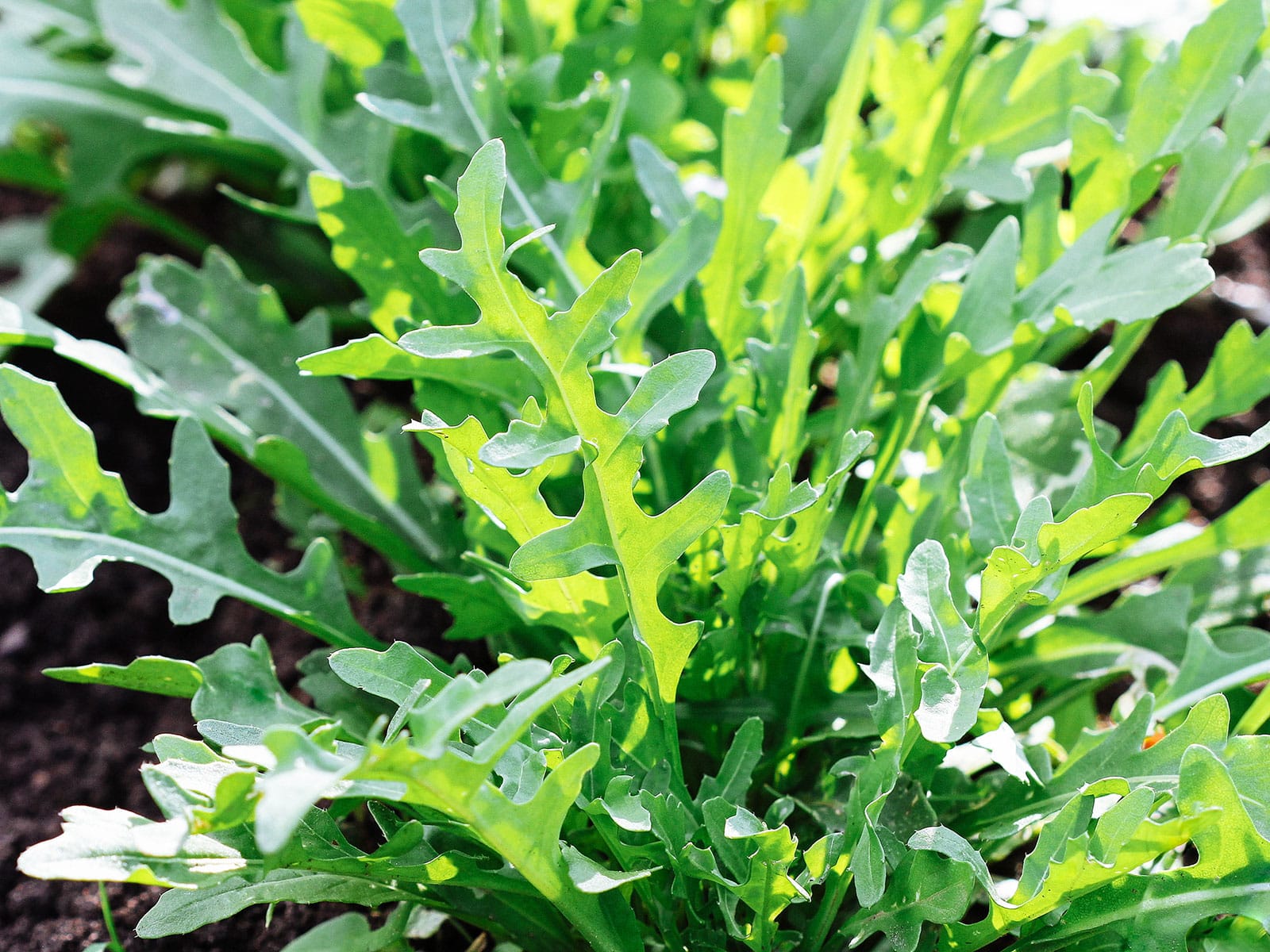
You don’t have to be without your salad greens in summer! While arugula comes from a family of plants that prefer cooler temperatures, arugula itself isn’t picky about weather.
Mature arugula can withstand surprisingly high temperatures for a leafy green (I grow it all summer in my high-desert garden), so make sure you plant it before it gets too hot and give it plenty of water during heat waves. If you sow or transplant arugula in June or July, do so under shade cloth or in a spot where taller plants will shade it in the afternoon. Sow seeds every couple weeks so you have garden-fresh arugula all summer long!
Mizuna
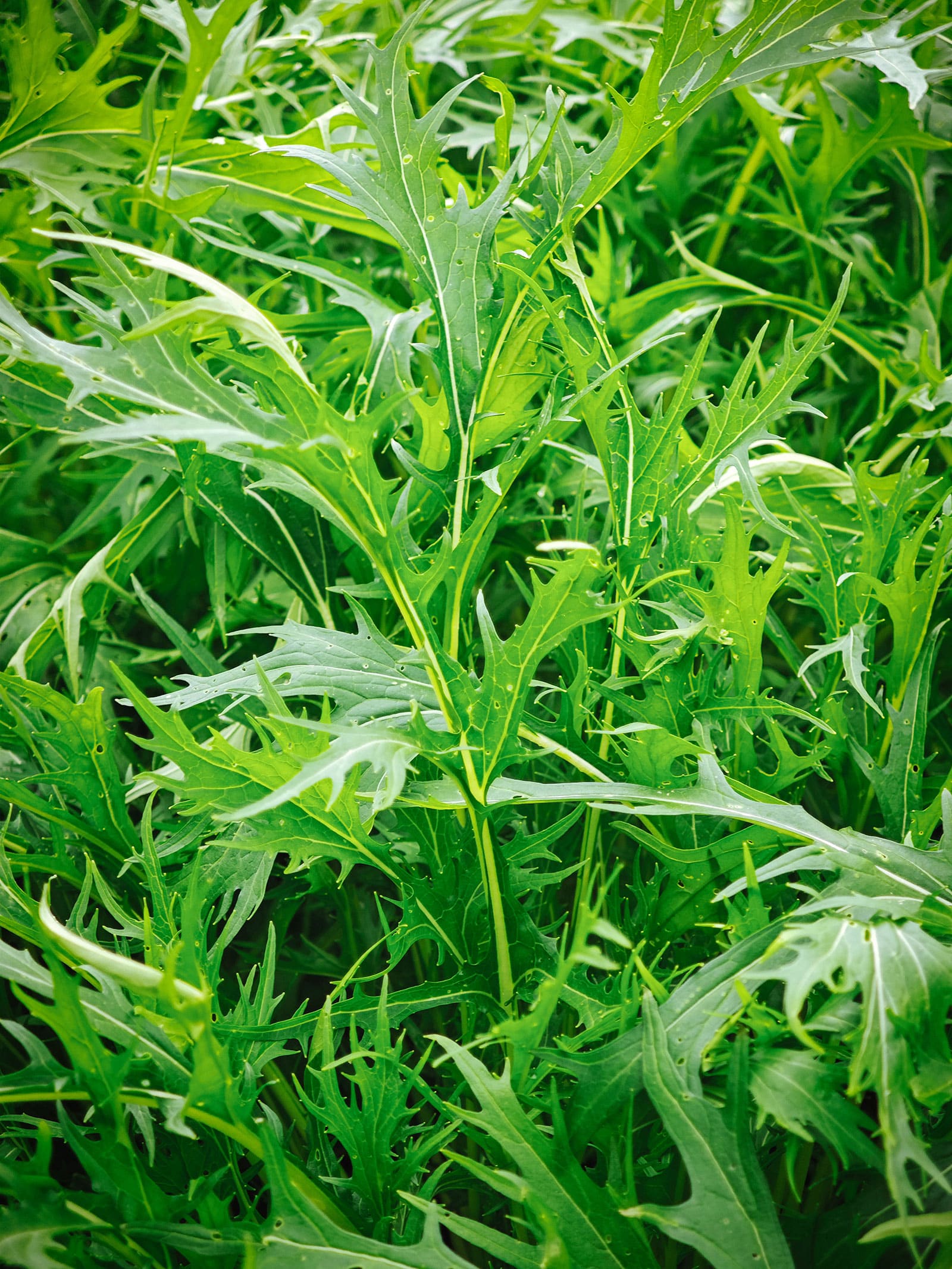
This Asian mustard is another salad green I love and grow through the hottest weather. It’s pretty mild for a mustard (definitely milder than arugula) and can be harvested in the baby leaf stage or when it’s more mature.
Mizuna is one of the best heat-tolerant salad greens to grow all summer, along with other mustards like yukina savoy, Tokyo bekana, and red leaf amaranth.
Where to buy
Kale
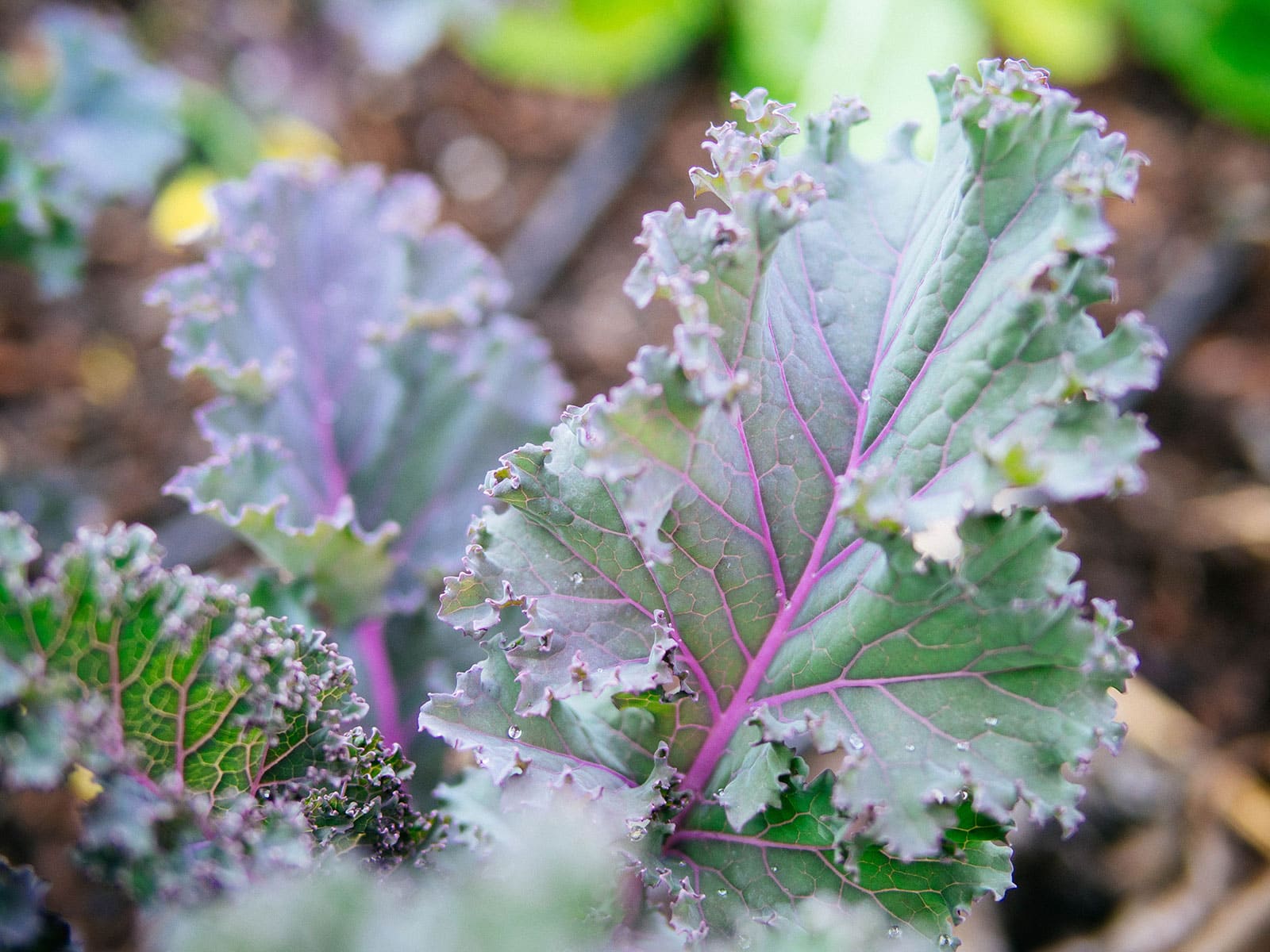
As a biennial, kale grows all summer long, overwinters beautifully, and comes back every spring. Even though cooler weather is where it really shines, kale doesn’t mind hot weather (especially if it has a bit of shade in the afternoon).
The trick is planting kale before it gets too hot, as mature kale plants fare much better than young starts, and choosing a variety that’s known for its heat tolerance, such as Dwarf Blue Curled, Dazzling Blue, or Portuguese kale.
Where to buy
Chard

Like kale, Swiss chard is a biennial that pushes through all summer before overwintering in your garden. Its tender leaves are prone to wilting in extreme heat, so it’s best to give it some afternoon shade. (It will perk right up again once the sun goes down.)
Plant chard when the weather is still nice and cool so it has time to establish roots before summer.
Malabar spinach
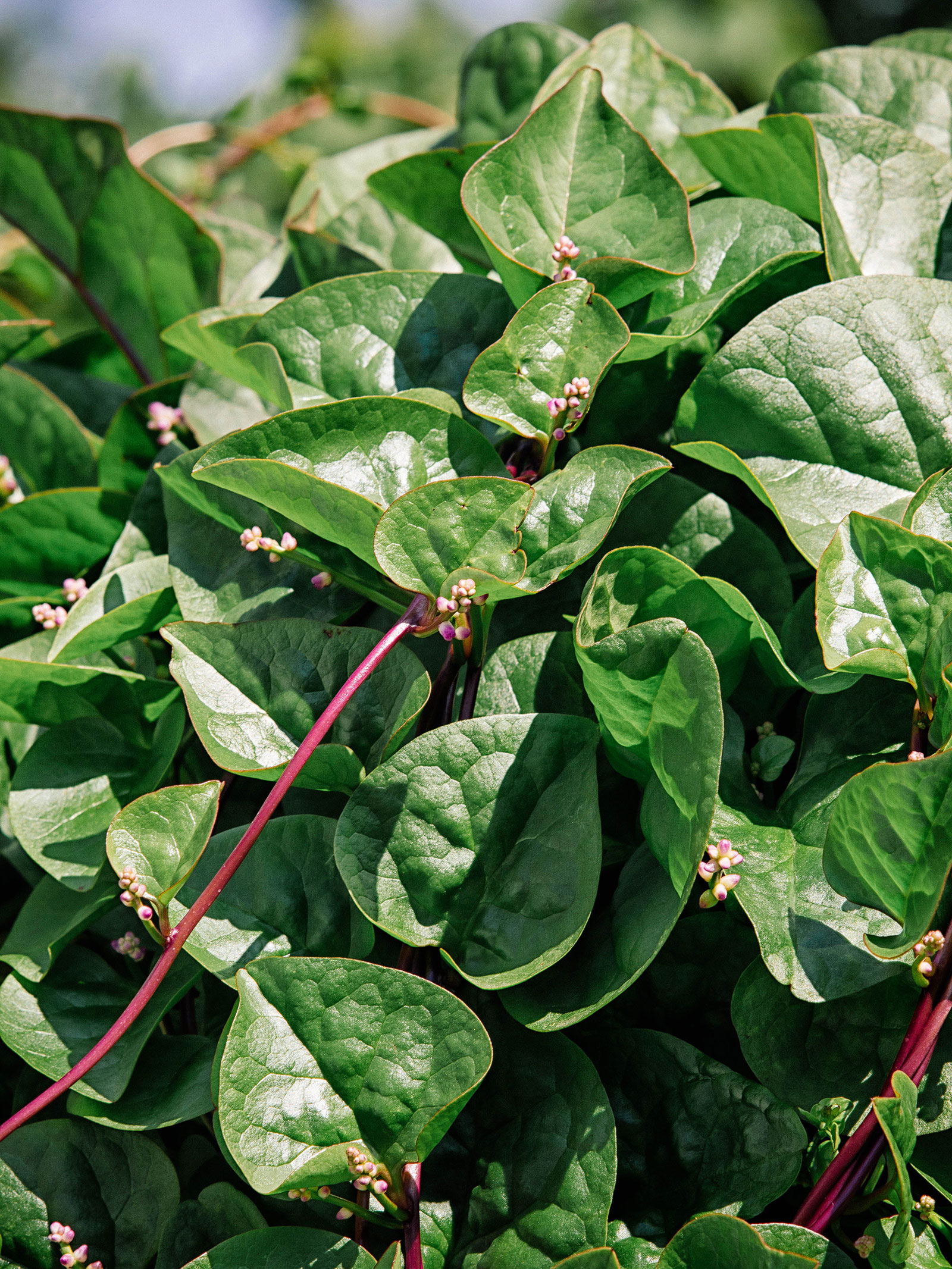
I grew this leafy green in my old garden in Southern California against a brick wall that faces south—so I know it likes the heat! It’s a vigorous climber that needs a trellis for support, and the hotter it is, the denser it becomes. In zones 10 and above, the tropical edible vine grows as a perennial.
Despite its name, Malabar spinach is not a spinach or even related to spinach at all—it’s a species in the Basellaceae family. Its glossy, succulent leaves have a mild, slightly peppery taste, and can be eaten raw in salads or cooked like spinach (though be aware that it’s mucilaginous when cooked, similar to okra).
Where to buy
Tomatillos
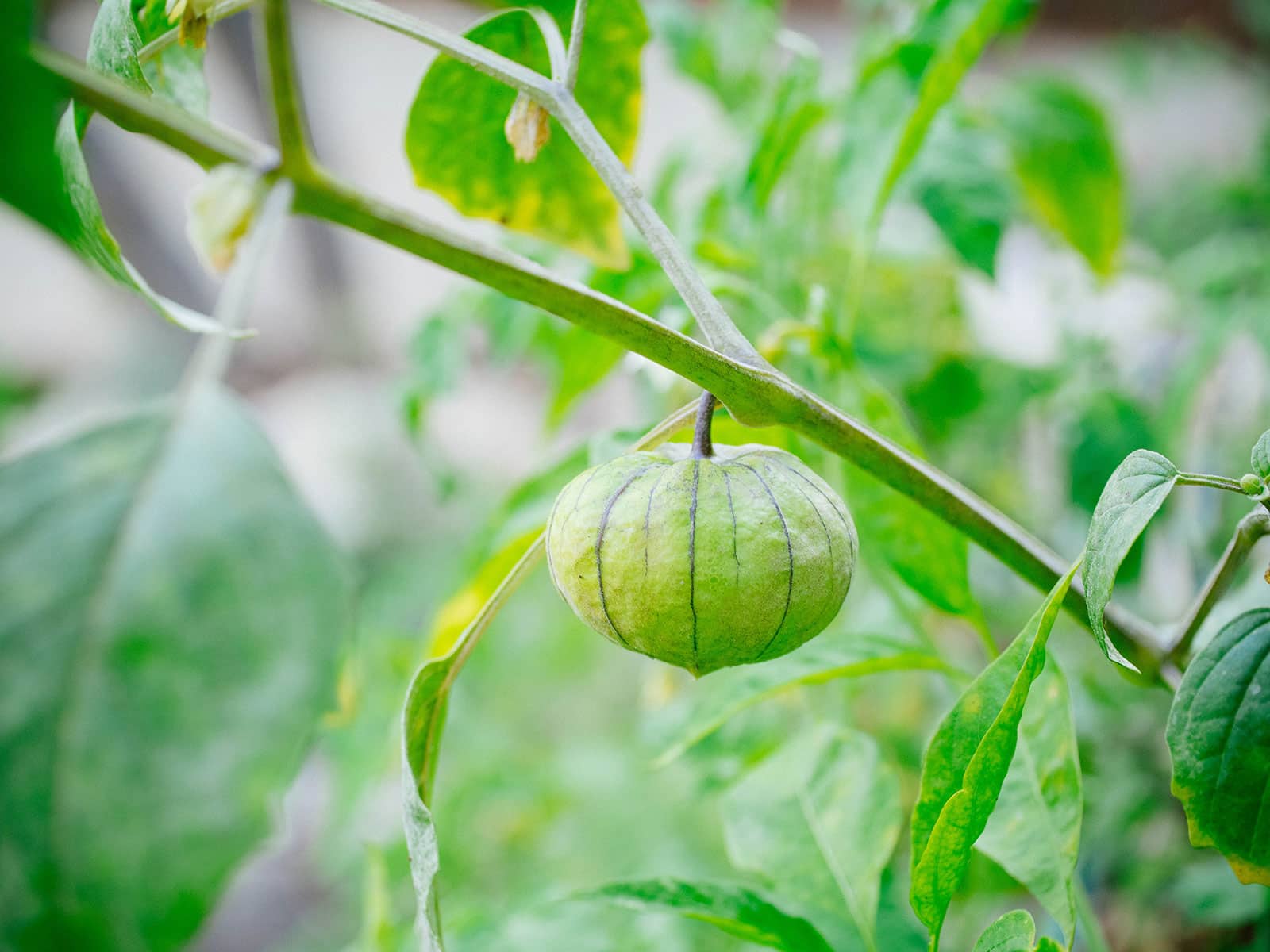
Tomatillos, a species of ground cherries, are native to Mexico and Central America, so they’re used to setting fruit in hot weather. And if you know how to grow tomatoes, then you’ll have no trouble with tomatillos!
Size wise, they’re somewhere between tomato and pepper plants, and they do best with a small trellis to support their fruit-laden stems. Plant at least two tomatillos so they can pollinate each other.
Chile peppers
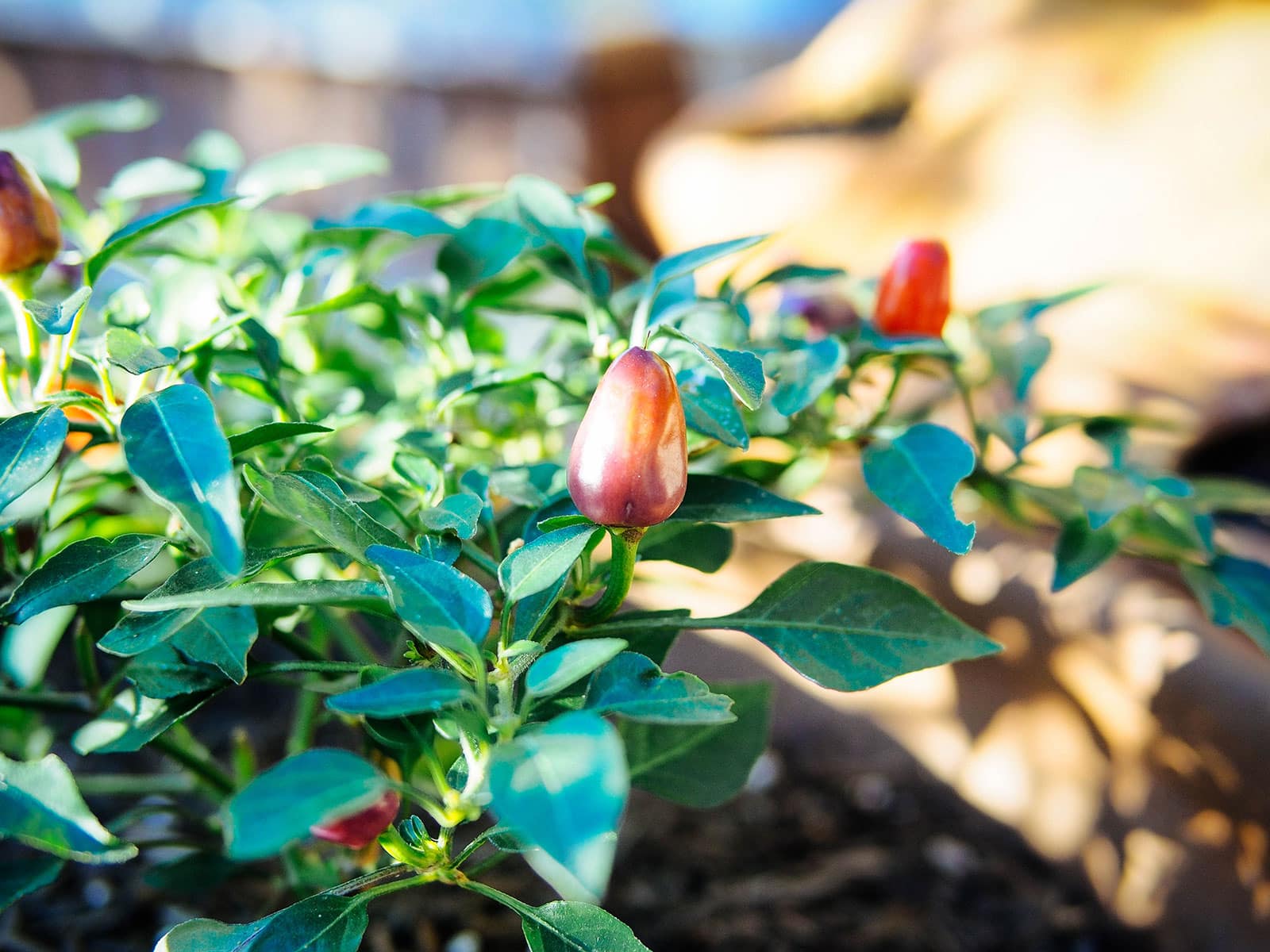
You’ve probably noticed this when you started your seeds indoors: hot peppers like heat and not only do they require heat to germinate, they don’t really get going until the nighttime lows are consistently above 60°F.
This includes jalapeños, serranos, habaneros, shishitos, Thai chiles, and the like. They are much more heat-tolerant than sweet (bell) peppers, and while they’ll reliably set fruit when temperatures hit 90°F, they’ll be happier with afternoon shade if it’s blazing all day.
Eggplant
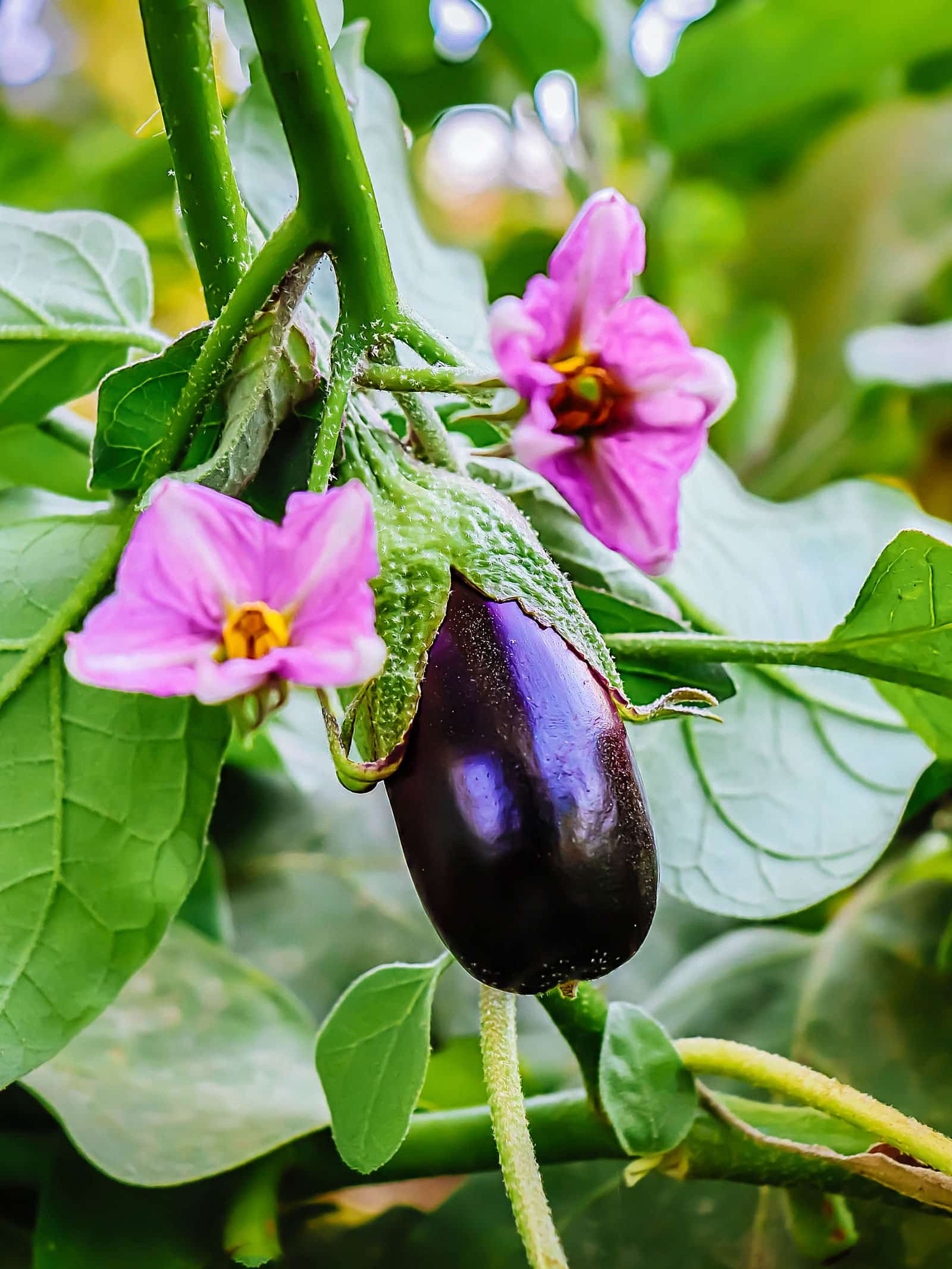
Similar to chile peppers, heat-loving eggplants have an optimum temperature range of 70°F to 90°F to set fruit. The plants start taking off once nighttime lows are consistently above 60°F, so wait to transplant your seedlings until the weather is warm enough to support their growth.
If temps exceed 95°F, eggplants need some shade during the hottest part of the day to continue fruiting. (The plants will make it through intense heat waves if they’re well watered, but they won’t fruit until things cool off a bit.)
Armenian cucumbers
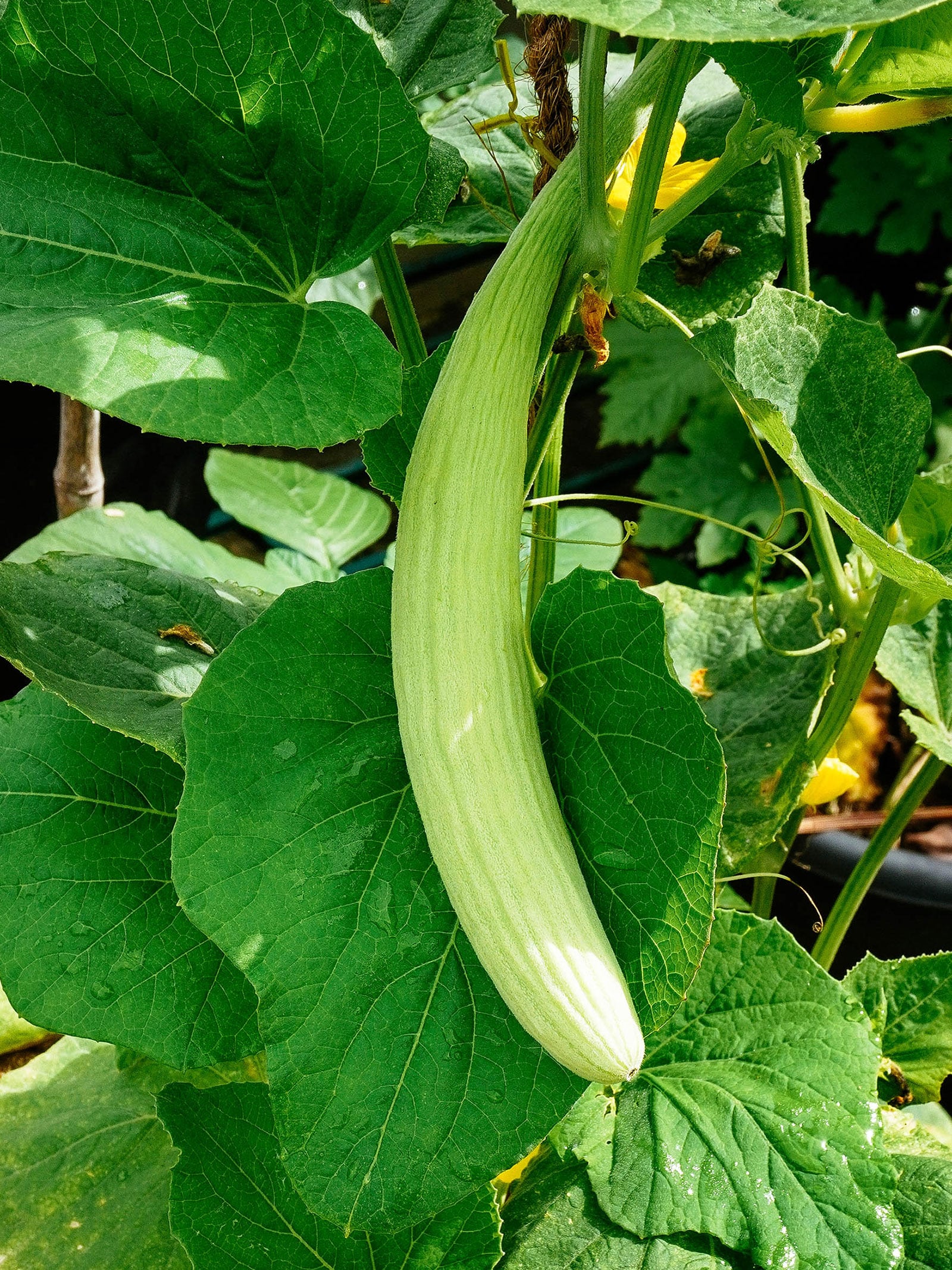
I’ve grown a few different types of Armenian cucumbers over the years (including this Metki Painted Serpent melon) and found them to be very heat-tolerant—much more so than regular cucumbers.
But while they grow like cucumbers (on long vines that climb vigorously up a trellis), look like cucumbers (green, long, and slender), and taste like cucumbers (without the bitterness), Armenian cucumbers aren’t cucumbers at all. They’re a type of muskmelon!
And they’re definitely worth adding to your summer garden to go with your heat-tolerant salad greens.
Where to buy
Melons

Muskmelons (think cantaloupes and honeydew) and watermelons often need a long period of hot weather to mature. So if you typically take a break in summer because few plants will grow in your garden, you should give melons a try!
Melons need—no, demand—two to three months of constant heat, in addition to ample sunshine and plenty of moisture while they’re growing. During the ripening period, they’ll produce better quality fruit if conditions are hot and dry.
Luffa gourds
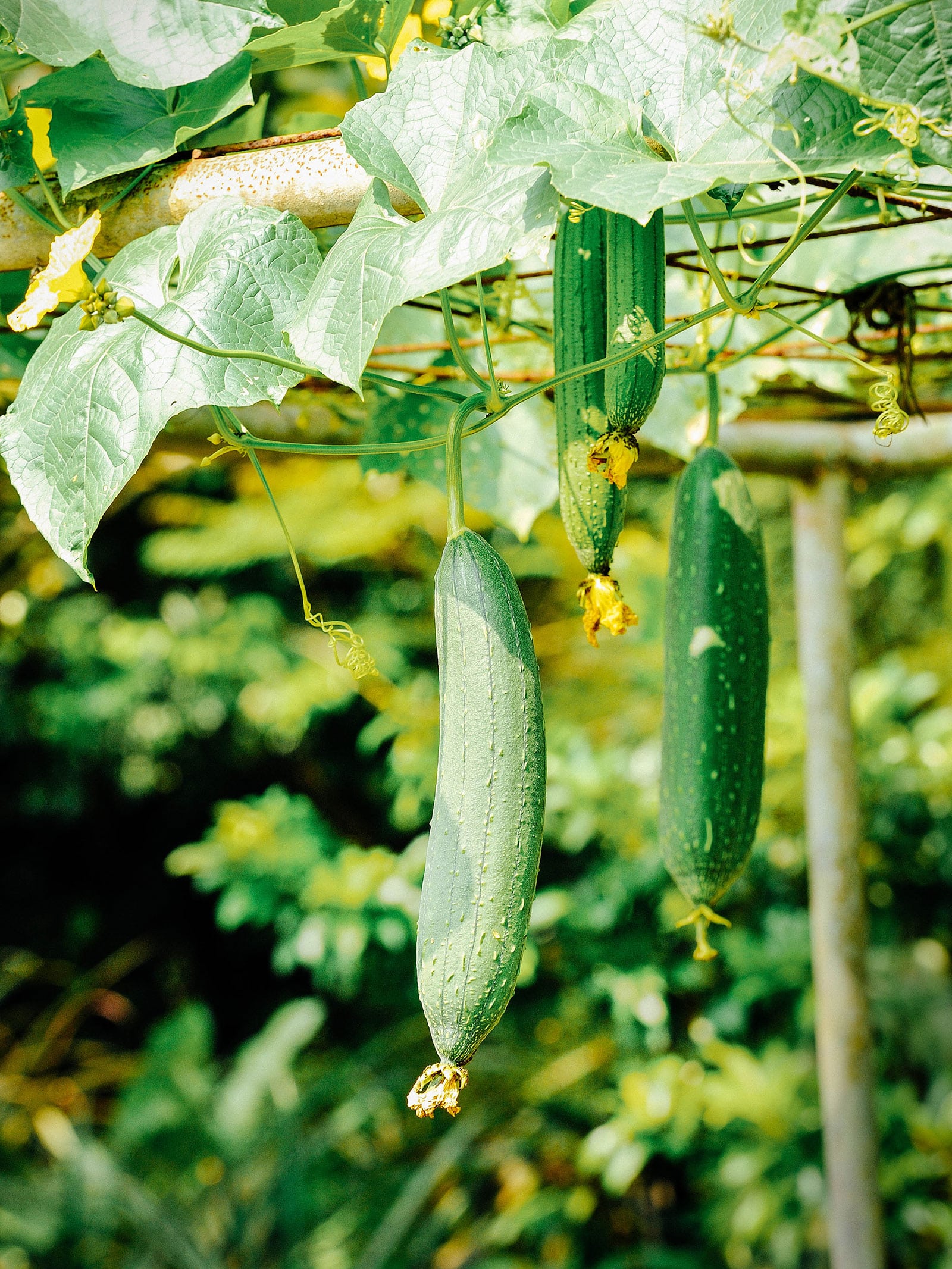
Yes, that kind of luffa, the scrubby sponge you use to wash your body or your dishes. It actually grows on a vine!
Luffa gourds (also spelled loofah) can be tricky to grow because they require a looong season of at least 110 days to mature. Many people start their plants off in greenhouses, but if you live in a hot climate, you can sow seeds directly in the ground in early spring and watch it take off all summer.
Where to buy
Winged beans

Winged beans are a type of legume known for its distinctive frilly edges. This is a vegetable that thrives in tropical and subtropical climates, and it likes things HOT! In fact, I successfully grew winged beans in my coastal Southern California garden for only one season—despite being in zone 10b—because our mornings and evenings were usually too cool.
But if you’ve got the kind of weather that winged beans prefer (think Texas, Florida, or Hawaii), you’ll love this unique crop. Every part is edible, including the pods (which you can eat like green beans), the leaves (which are tender like spinach), the flowers (which look beautiful in a salad), and the roots (which are starchy like potatoes).
Where to buy
Yardlong beans

Also known as Chinese long beans or asparagus beans, yardlong beans are native to Southeast Asia so it’s not surprising they can take the heat.
While mine have never gotten a full yard long, they do grow at least 10 to 20 inches long. In my experience, however, yardlong beans are best harvested when the pods are pencil-thin and no more than 12 inches in length. Use them the same way you’d use green beans!
Where to buy
Sweet potatoes
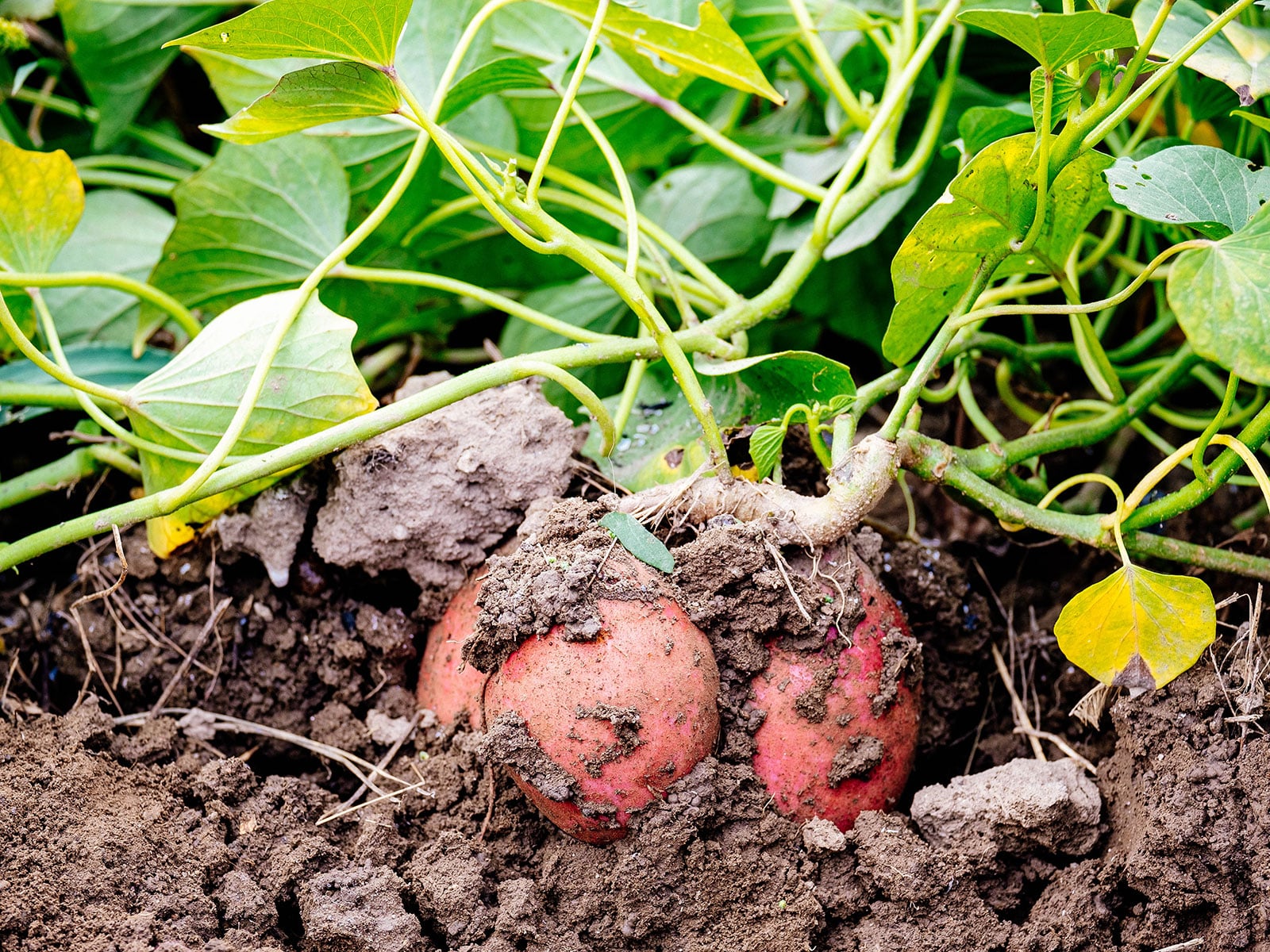
This is another food crop that’s native to tropical regions, so long, hot days are a sweet potato’s best friend. (This is in stark contrast to regular potatoes, which grow best in cooler temps.)
Sweet potatoes flourish in super hot weather above 90°F and are drought-resistant, so if you’re planning to go away for summer but still want a vegetable garden, plant sweet potatoes! They’re as low-maintenance as you can get.
Sweet potatoes will do their own thing (even in poor, sandy soil) and produce loads of delicious, tender vines (that are edible—cook them just like spinach) and large, sweet tubers (that can grow to the size of a football in some cases).
Okra
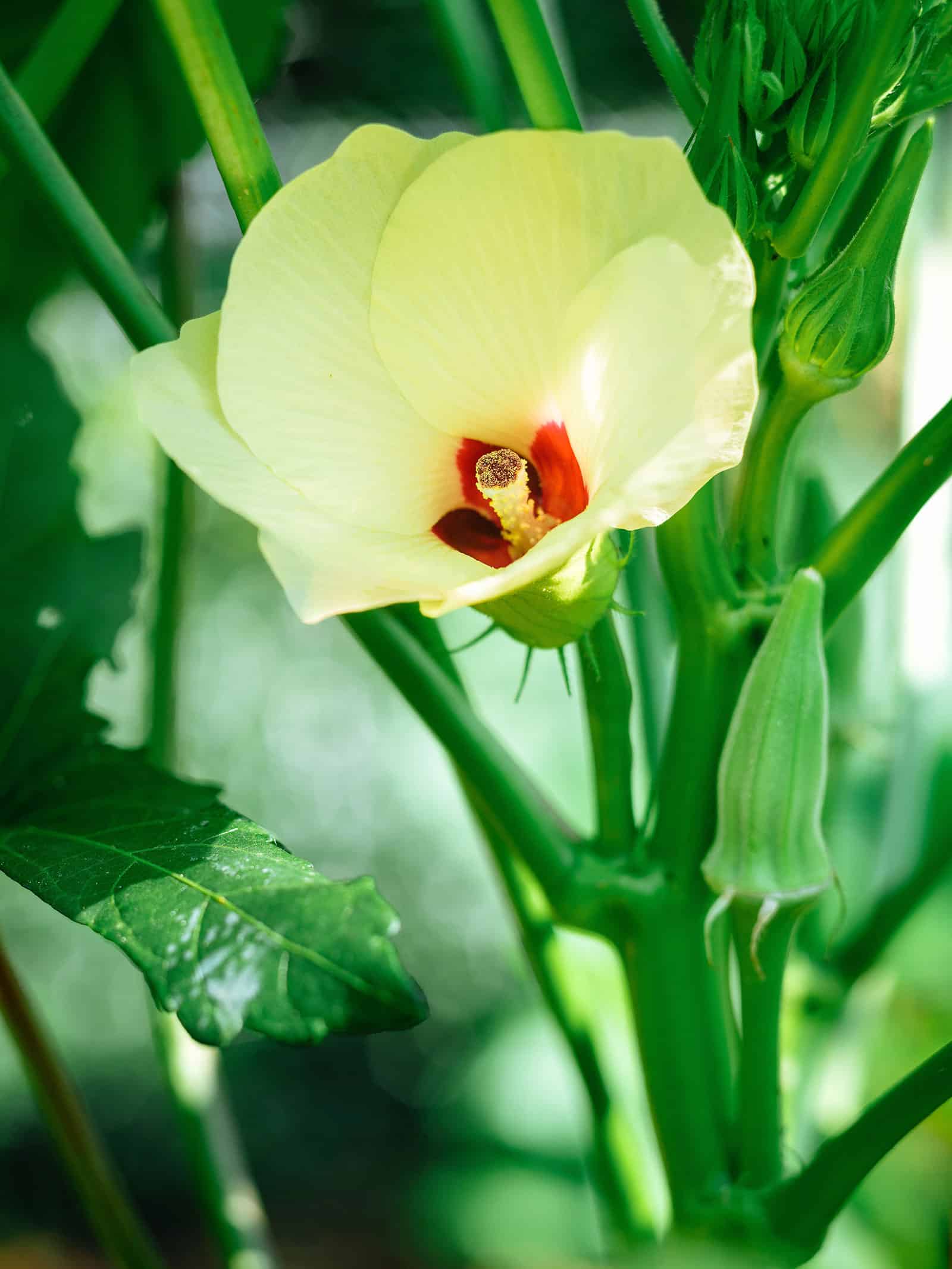
I once visited a friend in Texas in summer and found out a farmers’ market was happening nearby. When I asked if we could go check out the produce, he jokingly said, “There are only two things that grow in Texas in summer: beef and okra.”
Which means that yes, okra will absolutely thrive when it’s 100°F and 100 percent humidity in your area! This is one of the most heat-tolerant crops you can grow, as okra needs lots of hot days and warm nights to produce pods. Don’t even think about transplanting your okra until daytime temps are consistently over 80°F!
And even if you don’t like okra, the plants are still worth growing for their gorgeous, tropical-looking flowers; okra comes from the same family as hibiscus.
Ginger
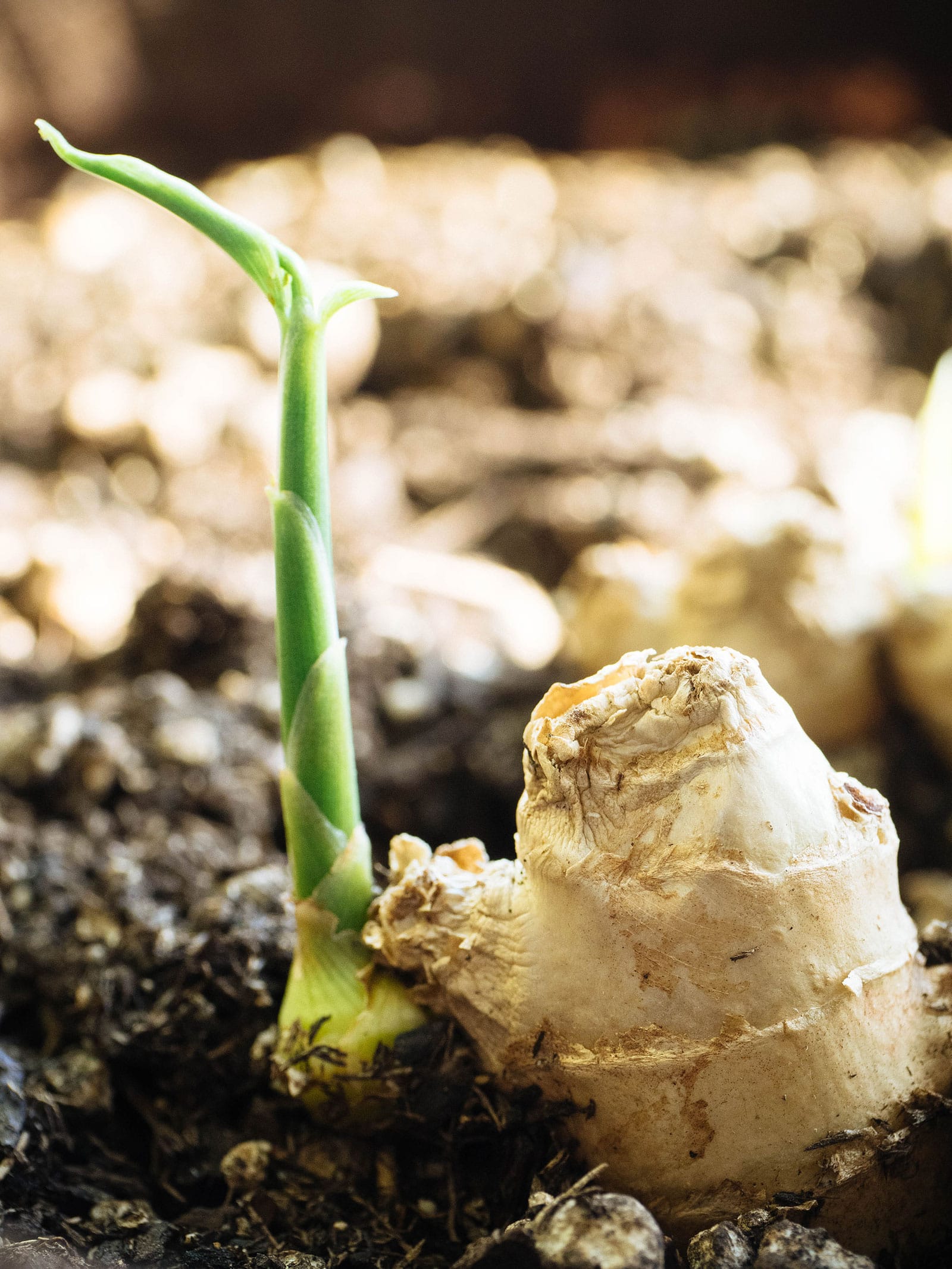
As a tropical plant from Southeast Asia, ginger thrives in heat and humidity—but unlike some of the other plants on this list, it doesn’t like to be in direct sun when it’s over 90°F. Give it dappled shade if your summers tend to sizzle, and make sure your garden bed has consistent irrigation.
The rhizomes will multiply themselves underground until the weather cools off in late summer. Once your average nighttime temps drop below 60°F, start digging up the rhizomes.
Mint family
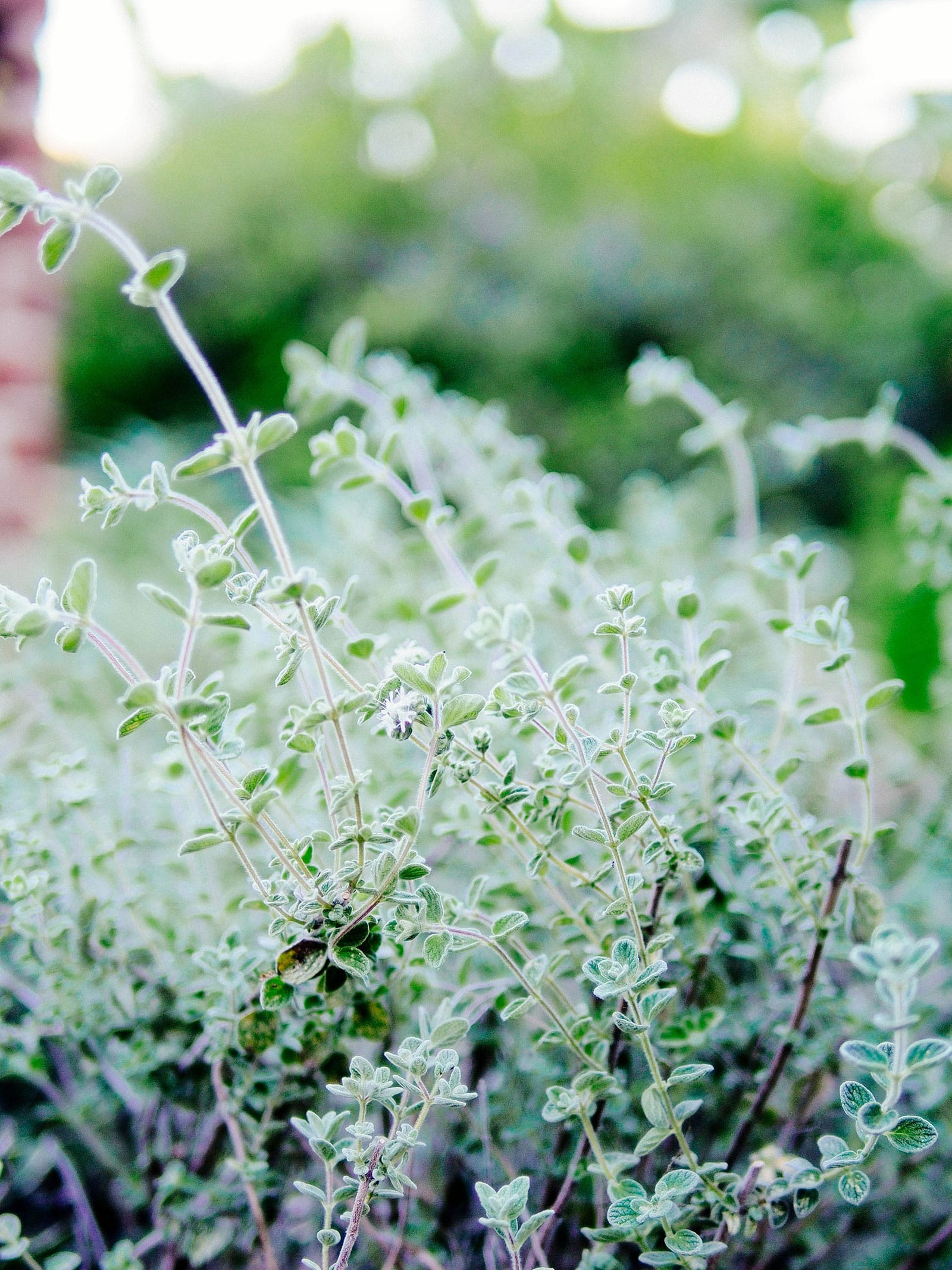
Most herbs in the mint family (including oregano, rosemary, sage, and thyme) originated in the Mediterranean, so they’re used to hot weather and can survive scorching summers if they’re given a little afternoon shade. (No need to drench them to keep them alive.)
Many of these herbs also happen to be very cold-hardy as well as heat-tolerant, so they’re ideal for climates that experience both weather extremes (hard frosts and high heat).
Two notable herbs worth trying in your garden:
- Wild zaatar oregano, which thrives in hot, dry soil (I grew it in my Southern California garden over a several-year drought)
- Cuban oregano, which also prefers hot and dry conditions, though its succulent leaves need a bit of afternoon shade (I should add that Cuban oregano sometimes goes by the name Mexican mint, despite being neither an oregano nor a mint)
Where to buy
Basil
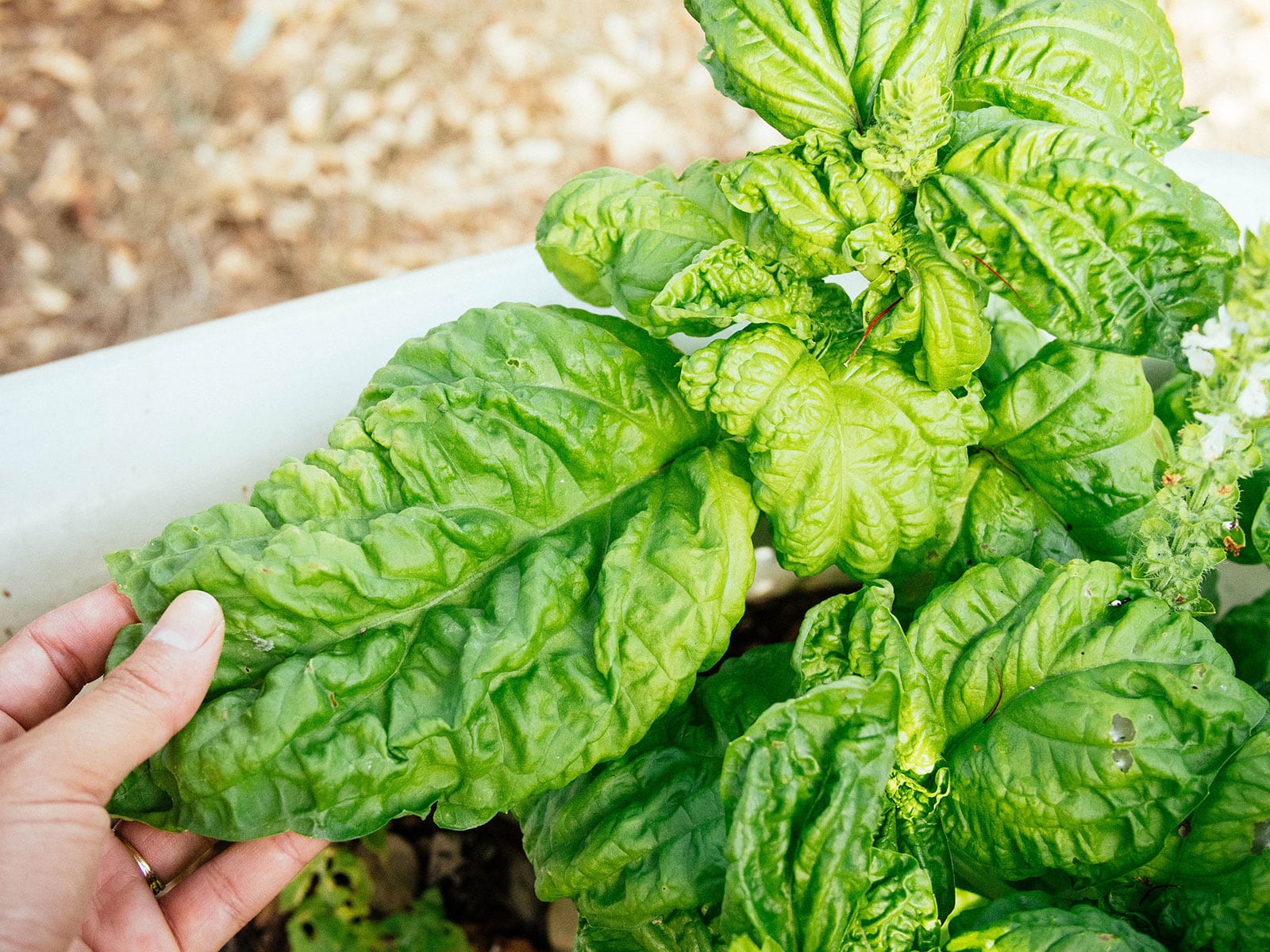
Even though basil is part of the mint family and often considered a Mediterranean herb, I list it separately here because it’s actually native to India, Southeast Asia, and the tropical African region—which tells you something about its heat tolerance!
One of my favorite cultivars is a perennial basil called African blue basil, which is a cross of ‘Dark Opal’ and camphor basil. I also love the large-leaf crinkled variety known as lettuce leaf basil or salad leaf basil—not only does it it produce mildly sweet leaves as big as my hand (so good on sandwiches!), it’s slow to bolt so you can harvest it over a longer period.
Where to buy
Garlic chives
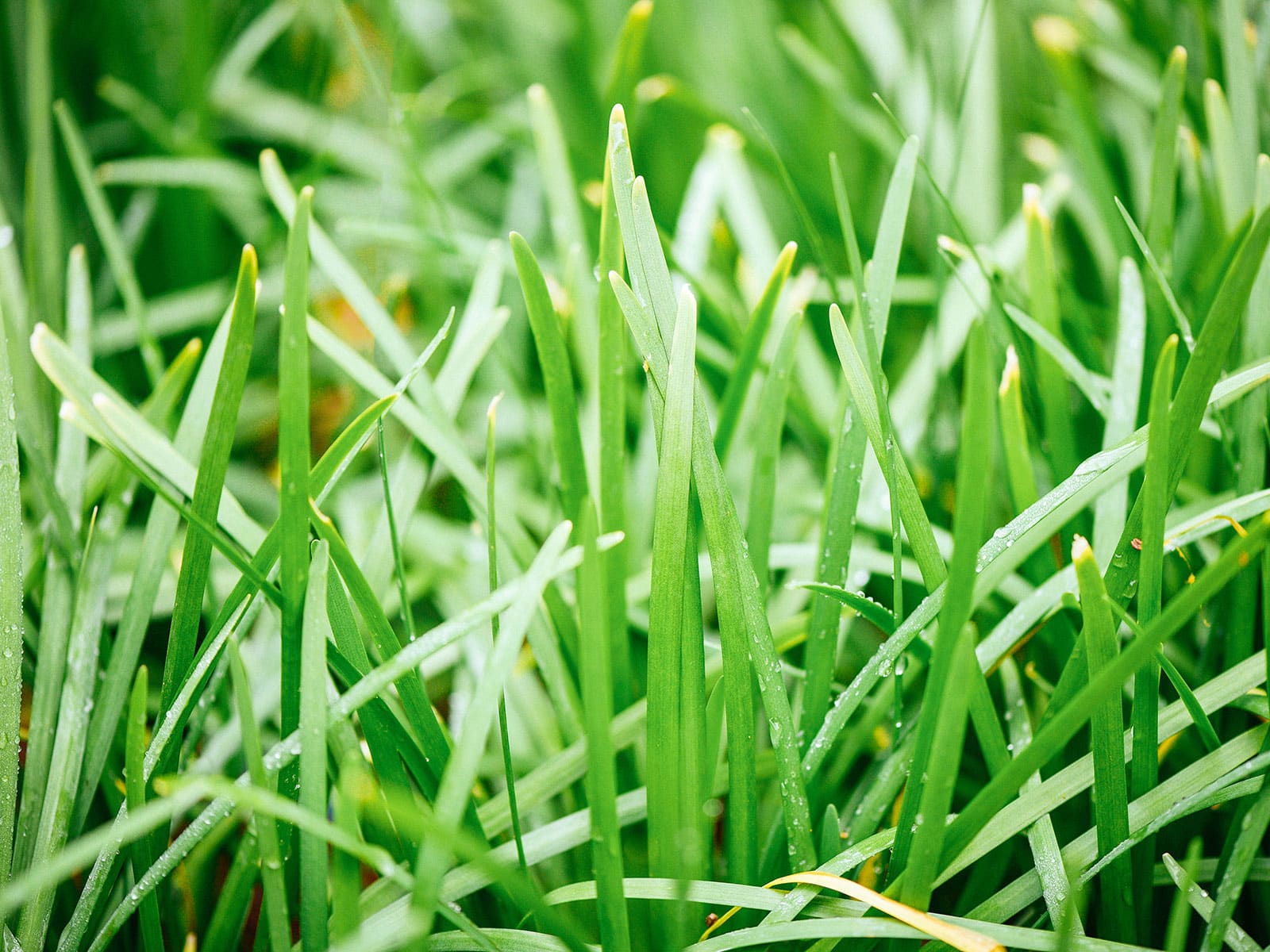
This is one of the few crops that my parents (who live in Las Vegas) grow in their backyard all summer—without having to provide shade!
Garlic chives (also known as Chinese chives or Chinese leeks) are extremely resilient, able to withstand both hard frosts and hot summers. They’re heat- and drought-tolerant but also thrive in humid climates, given their origins in southeastern China. At temperatures above 90°F they may go dormant, but will resume growth when conditions are more favorable.
You can tell garlic chives apart from onion (common) chives by their stems: garlic chives are wide and flat while onion chives are narrow and tubular.


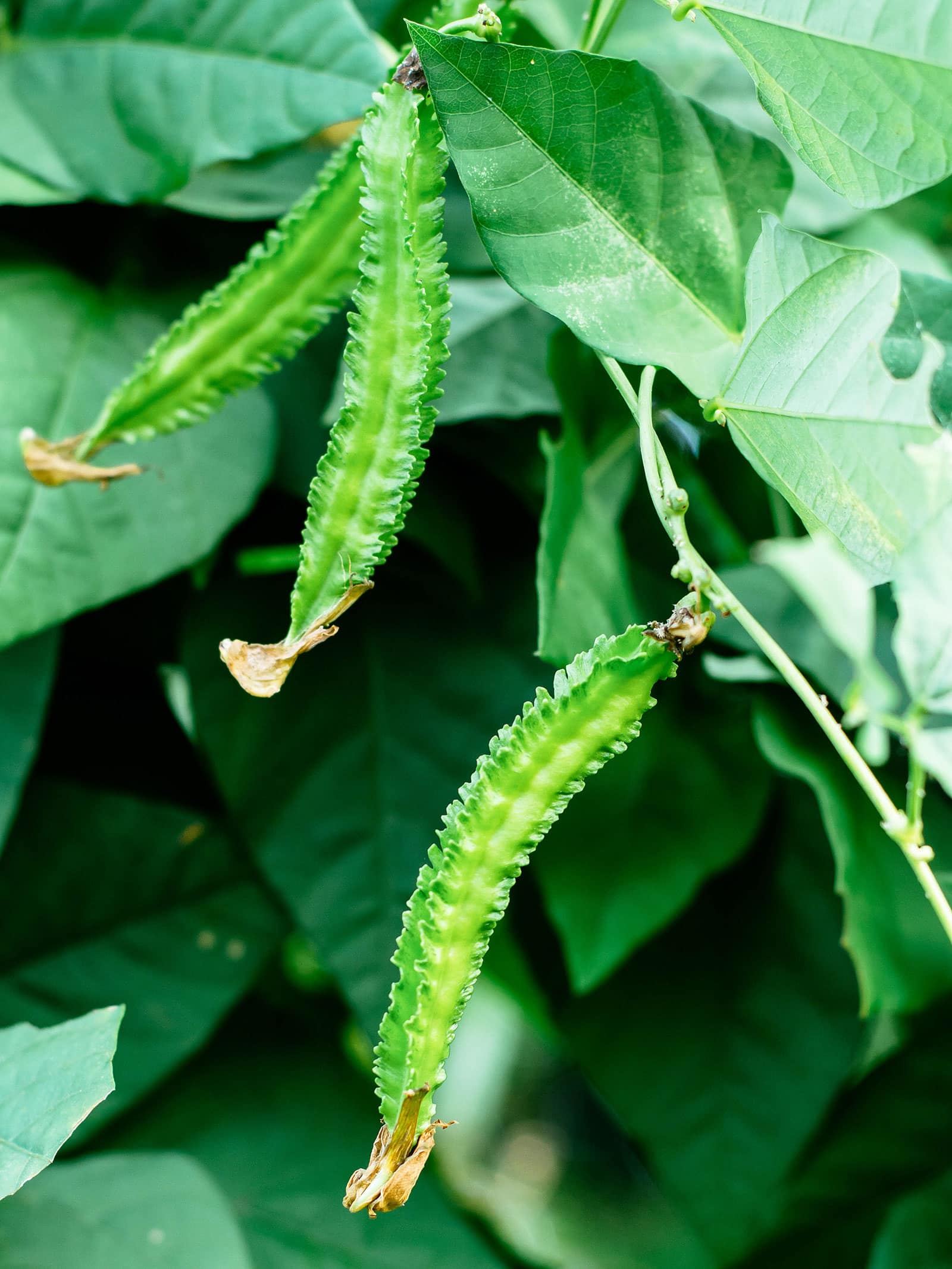
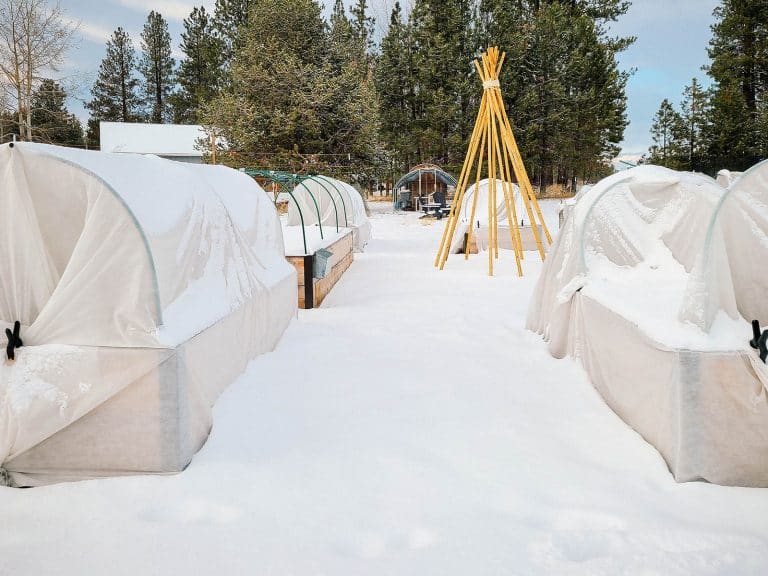
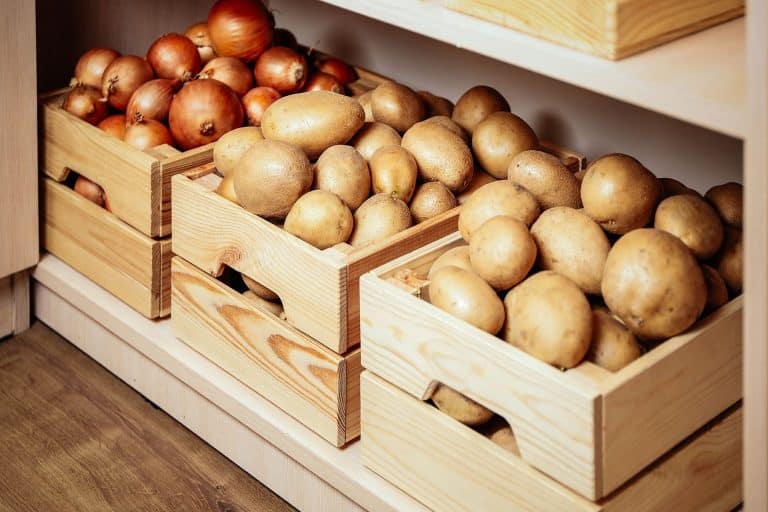
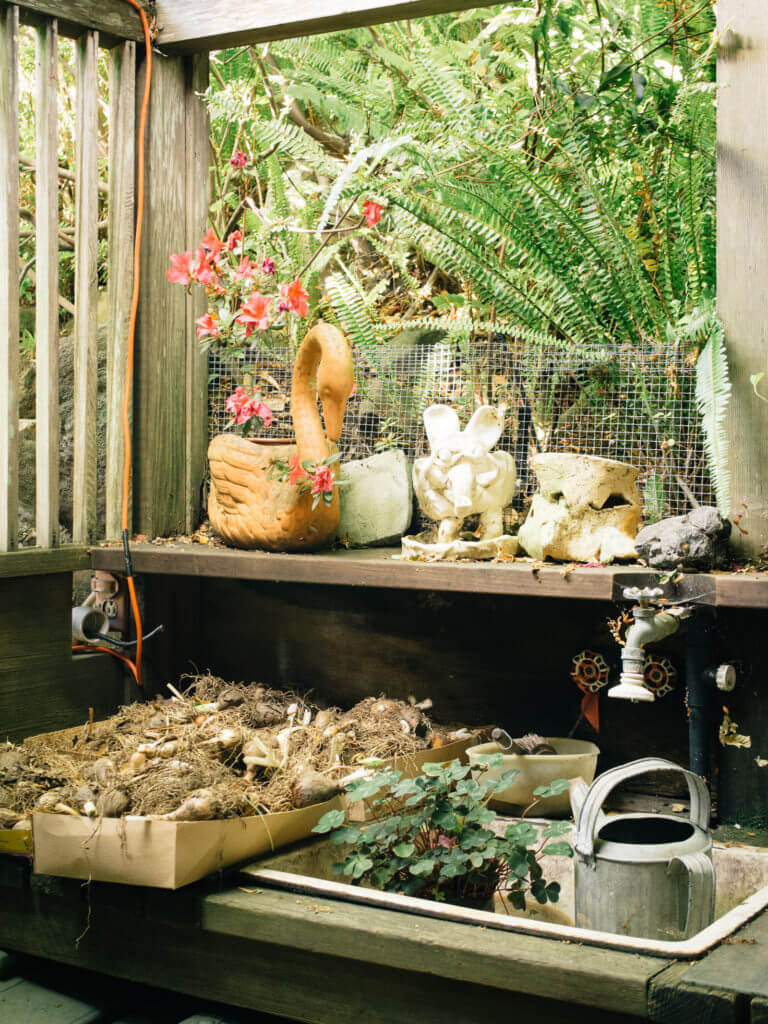
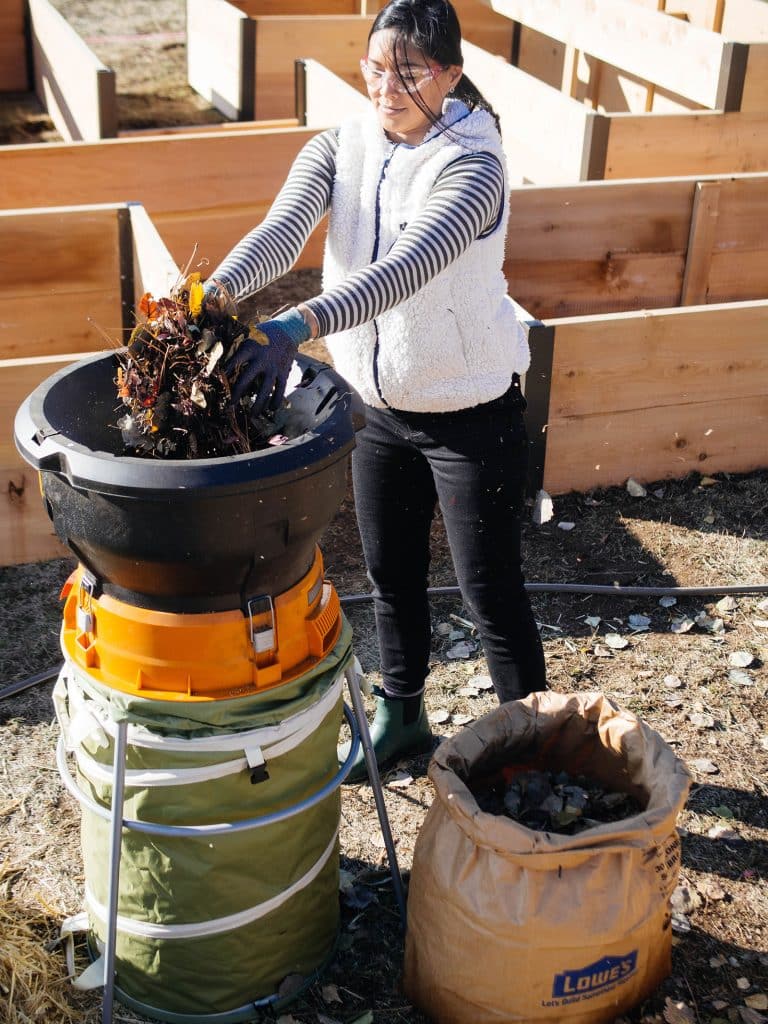


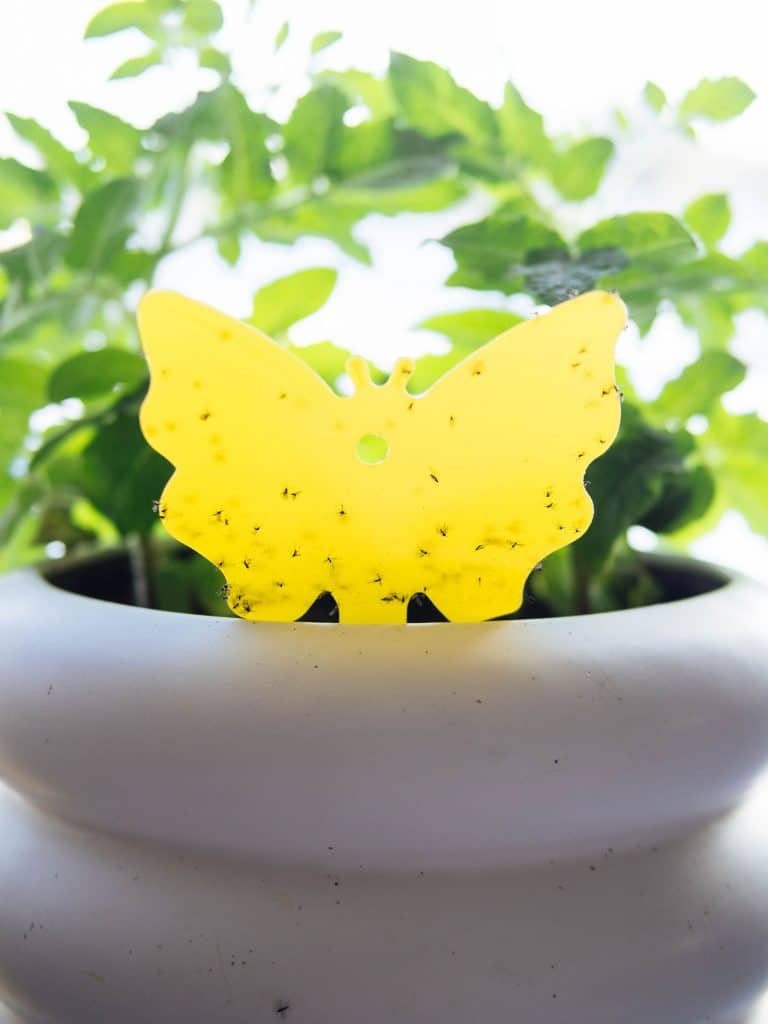

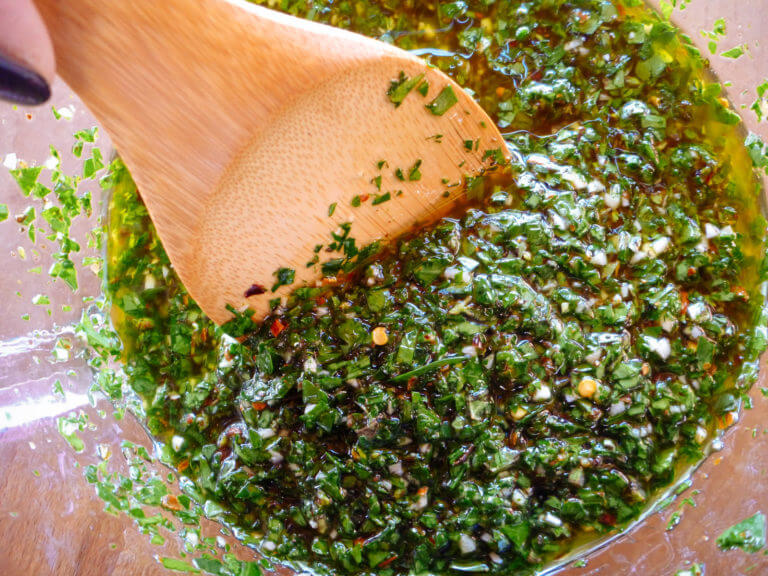


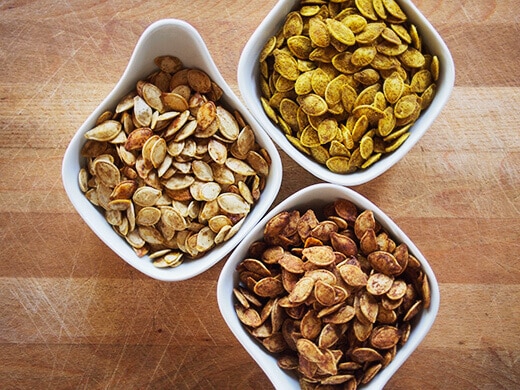

Thank you, Garden Betty!
Nice one. In areas that receive light or no frost, there are a whole battery of perennial vegetables. I was still learning about some when a health event occassioned out move to my daughter’s place in Vermont. Several, in this newsletter, are perennial, as you know, and you mentioned others lately. A number of perennial vegetables such as peppers and lima beans have been annualized by plant breeders for the tropics. I found it useful in north-central Florida to interplant annual temperate zone vegetables in moringa. I grew biennials such as broccoli over winter and accommodate herbaceous tropical perennials such as Gynura procumbens (a viney plant used as a potherb) as understory for summer harvest. I’m surprised that you did not include Lima bean in the list. (One of the annualized tropical perennials. ECHO in North Ft. Meyer Floria was distributing a vining variety called something like “Seven Year”, which retained perennial habit, and may still do so. Cacti in the Opuntia genus are a perennial vegetable (tuna or tona) and also produce edible fruit and can serve as a living fence. There are species that are native in North America as far north as the Dakotas–J L Hudson Seedsman offered it at one time–the current owner may still know of a source of seed. He offers only one species this year–from Texas. Vacationing in the Florida Keys, my daughter picked a gallon or two of fruit which my wife utilized as an ingredient in in a sort of key lime pie (possibly sour orange, which we had in abundance). The pie was delightfully purple. Prickley pear (Opuntia spp. fruit) are an excellent source of dietary potassium. Eric Toensmeir’s book Perennial Vegetables has a number of perennial temperate zone candidates that handle heat. (In general, except for interplanting specific annual vegetables, it is wise to keep the perennial garden separate from the annual garden, due to the need for different soil management strategy options. One other thought, Anna, a student in my online permaculture design course living in South Africa, interplanted winter vegetables in the lanes between grape trellises. (Winter was their rainy season.) It now occurs to me that somewhat drought & heat tollerant vegetables could be interplanted with her grapes in the South Africa hot, dry summer. The vines would provide beneficial shade. Vegetable crops would need to be harvested before it is time to harvest grapes. One would need to do trials to see how/if the vegetables affect grape yields, especially considering the dryness of the summer. Possibly removable containers would be optimal, elimating disturbance of the grape roots. Now I’m thinking that growing a buckwheat crop in the lanes between grapes could be cut, Fukuoka style (in full bloom), to provide high phosphorous mulch with heat tollerant vegetables in containers on top.
Sorry. I get thinking about this stuff and can’t stop.